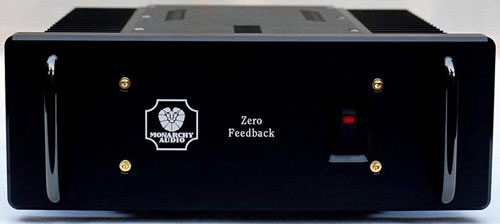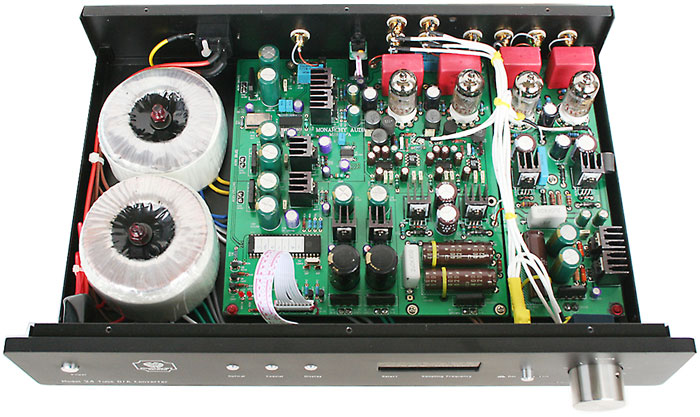If you buy equipment based solely on appearance, then you may not consider Monarchy Audio equipment. However, if you are like the majority of audiophiles who would not judge a component merely by the design of its front plate, then by the end of this review you may find reasons to try the company’s products out. See, I was smitten by the inner beauty of the Monarchy Audio line.
Under most circumstances I would advocate the pursuit of the “total package” component, the one with outstanding sound and looks. However, this is one of those rare times when it would not be prudent to do so at the oversight of the M24 Preamp and SM-70 Pro monoblock amplifiers. What could conceivably make me suggest this? You have heard of manufacturers who, out of a desire to benefit the audio community, create clean yet simple wares so that the audiophile-on-a-budget can afford higher performance. C.C. Poon of Monarchy takes that philosophy one step further – he has chosen to forgo a salary from his own company and he is determined to put the maximum into the components while taking the minimum from the company. That alone endears me to Monarchy Audio!
There is only one way this can be done; C.C. Poon has independent streams of revenue. He was smart, and invested in a chip company, and reaped enough to retire. Since he is not dependent upon the income from Monarchy Audio, he can devote more resources to the final product rather than his wallet. This makes C.C. a very good friend to the average audiophile! You can see why I like his products already!
“One does not realize just how good they are until looking under the cover to see that Monarchy components are well designed.”
If the performance of Monarchy equipment was merely mundane, that would be the end of the story. However, these components are not poor performers in pitiful garb. These are very fine components in pauper’s attire. One does not realize just how good they are until looking under the cover to see that Monarchy components are well designed. Compact and ergonomically efficient, Monarchy products are packed with value. The SM-70 Pro is a little wonder with its small chassis and tremendous toroid. It is an economical, true balanced power amp for very affordable price! The M24, on the other hand, is a study in over-delivering to the consumer as it is not only a solid-state DAC, but also a tube DAC and a full fledged tube Line Preamp! That kind of flexibility does not surface too often in an ocean of components. If Monarchy Audio equipment came in more extravagant, expensive , slick packaging, everyone would want them. Based on their existing build quality and performance, many should want it.
Monarchy equipment is designed and built by a man with a good ear for soulful music: C.C. He has obviously done a lot of tweaking and listening, as his components elicit a signature expansive soundstage which immediately beckons the listener the way a live performance satisfies the ear. Some components leave me with a flat feeling in that the signal is being reproduced in an “informationally” dense or technically complex fashion, but not in a way to cause me to emote. The Monarchy gear urges me to become emotionally involved, as I will discuss shortly.
The M24 Pre/Dac, currently in its second iteration, is a technical man’s component. It has a no-nonsense, utilitarian appearance and feel. Indeed, the tubes are no-nonsense as well, being acquired by C.C. from the military; they are 6DJ8 JAN (Joint Army Navy), and can take ECC88’s or equivalents. Controls on the slab-like black anodized aluminum face include two source buttons, a display on/off button, and a selector to switch between the external source and the internal tube DAC. The back is where things get unusual, with three sets of single-ended jacks labeled, “Line In”, “Line Out,” and “Analogue Output”. Optical and coaxial digital inputs are also provided.
To aid the owner in setting up the M24, Mr. Poon has provided a schematic.
It is not easily understood for a non-technical person. This M24 is not about plugging in two interconnects and forgetting the rest. It’s a “Configurationist’s” unit. A “Configurationist” is the electronic equivalent of the contortionist in a circus. During use, there were times when wires were routed back and forth into several configurations on the back of the M24. If you’re looking for a “plug and play” option, or never want to think about the meaning of the wires in back, then this unit is understandably not for you. However, I suspect the majority of readers in this hobby are not daunted by the idea of a couple extra interconnects and might also be interested in wresting top-notch performance from the M24 in that manner. In that case, you will be interested in knowing just how many options are given for utilizing it.
In configuring the M24, only digital inputs are accommodated, and at that point resemblance to most DAC’s ends. Since this unit is both a SS DAC and a tube DAC, one must select the manner of conversion desired. The instructions (there is no formal Manual – something which this unit particularly could benefit from!) attempt to be helpful, but since they are a schematic, they do not clearly benefit the layman. Truthfully, they likely will leave the owner confused. C.C. admitted that he fields calls from owners and has to instruct them on setup. The setup is easier than it looks in the schematic, however it would be to his advantage time-wise, and to the increased satisfaction of the owner, to create a proper, well worded Manual with pictures. But, again, do not let that dissuade you if you are in search of economical excellent performance.
The owner has the option of selecting either Digital input or Analogue input. The default operation runs the signal through the tube DAC. The user has the option of bypassing the tube DAC in favor of the SS DAC. A switch at the front of the unit allows this easy selection. On the backside, a pair of IC’s must be run from the “SS Out” ports to the “Line In” ports to accomplish this. When set up thus, a simple flick of the front panel “Tube DAC/Line In” switch alternates between the two forms of digital conversion – wonderful for comparisons between the two DACs!
In order to obtain optimum quality from the SS DAC, a “coupling transformer” is recommended, which is placed in the exact same location as the pair of IC’s. In other words, one can simply use a set of IC’s, but to obtain better results a coupling transformer is preferable. The transformer will filter out digital artifacts from the solid-state DAC, although the tube DAC is preferred by C.C. himself. The nature of tubes, according to one piece of literature, “…has some inherent filtering characteristics above the ultrasonic range.” An owner can get along fine without the coupling transformer; I found the SS DAC sound to be quite palatable by simply using ICs, and the unit was quite sensitive to the nuances of changing interconnects.
I asked C.C. on the “dual DAC” setup, and he had several ready answers listed for me:
1. The SS output can challenge other SS DAC’s with 24/96 functions;
2. It provides a second set of outputs for subwoofer connections;
3. It allows the user to compare the SS DAC out versus the Tube DAC out;
4. It gives tremendous value for the money as the M24 is a three device unit –
SS DAC, Tube DAC and Tube Line Amp, all in one package;
5. It allows the user to directly compare SS to Tube DAC operations
“One can become familiarized with the [M24’s] SS DAC to the point that any tube compliment change will be easily compared.”
I found that I liked having the options offered by the M24. Although I used the SS DAC function very little in comparison to the Tube DAC, I can see where the comparison can be extremely compelling. One can become familiarized with the SS DAC to the point that any tube compliment change will be easily compared. This is the first unit that I have ever seen which allows such direct, fixed comparison to a standard. Sure, one can swap cables and units to compare a SS to Tube DAC, but not on the fly! If you really want to know if a particular set of tubes measures better in your mind, the SS function gives you a yardstick to measure.
My suspicion that C.C. is a dyed in the wool tinkerer was confirmed when he sent me a project that he’d been working on. It was a homemade coupling transformer, essentially a TVC (Transformer Volume Control) with switchable low- and high- impedance output and a headphone jack, housed in a repurposed aluminum electronics casing. As an experimental piece, it looked much rougher than production Monarchy equipment. The silk-screened labels for the previous functions were to be ignored, and the new functions were indicated by tape labels applied to the casing. The unit looked downright dangerous with 4 sets of single-ended jacks, an unlabeled switch and oversize volume control – even a headphone jack – all on an aluminum box not much larger than a few decks of cards! There were no directions, so it took a phone call to C.C. and some experimentation to get the feel for it.
Frankly, the thing looked ghastly, but performed well – Monarchy methods taken to the extreme. To be fair, this creation was not officially part of the review, as C.C. didn’t have an official unit available. Rather, it was a curiosity piece to demonstrate the use of a coupling transformer with the SS DAC. With this addition, the quantity of IC’s on the back of the M24 had reached its zenith, using three sets. However, it would allow the ultimate in comparison between the two DAC’s in the M24.
“Uncannily, the sound of the tube DAC and transformer-enhanced SS DAC were extremely close …”
Whereas one can simply use a pair of IC’s to achieve use of the SS DAC on the M24, the insertion of the “coupling transformer” did elevate the quality of the solid-state performance. The lowest level of quality was from the use of the IC without the coupling transformer. Both the tube DAC and SS DAC with the transformer were substantially better. Uncannily, the sound of the tube DAC and transformer-enhanced SS DAC were extremely close, the tube version being a smidgen less punctuated and the SS version being ever so slightly cleaner. In fact, I would be hard pressed to identify either one without hearing them side by side and pushing the switching button myself! This was further evidence that C.C. really can make SS equipment that sounds uncannily like tubed gear!
- (Page 1 of 2)
- Next page →




